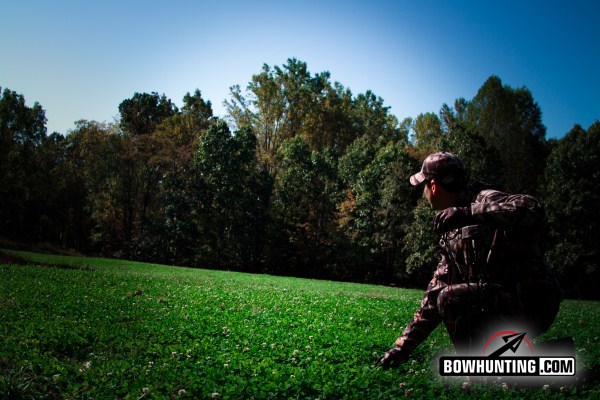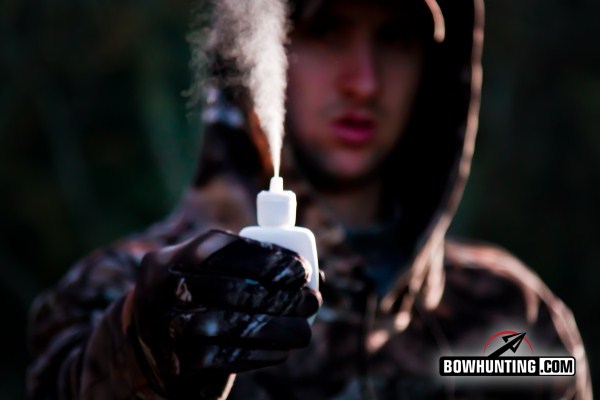LAST UPDATED: May 8th, 2015
If you have followed my blog with any regularity over the last several months, you are surely aware of the time, effort and enthusiasm I have poured into my food plots preparing them for the upcoming deer season. I have planted food plots regularly since 2007 and achieved good results, but this hunting season was going to be the first season I would spend considerable time actually hunting the plots. Whether it is hunting directly over the plot, hunting a man made funnel designed to push the deer past my stand on their way to feed for the afternoon, or hunting trails and runways hundreds of yards off the food plots trying to intercept the deer returning to their beds in the morning, I was excited. Well, after three hunts hunting the situations above, I am here to share my experiences and the lessons learned from each hunt.
Preparing a food plot for hunting purposes is a process that began way back in February when my brother, dad and I made a man made funnel to push the deer by my stand on their way to the food plot. The following month I frost seeded my clover food plots to give it a head start when spring’s warmth would kickoff the growing the season. It continued into the summer months with regular mowing to keep the weeds controlled and to ensure that the plot stays healthy and attractive to deer. Finally, as summer burned away into fall, I plated an additional strip of turnips and oats along the timber line of my food plots to provide some variety and increase shot opportunities should I decide to hunt directly over the plot. The day prior to opening day two weeks ago, I sat in my hunting camp a couple hundred yards off my favorite plot and observed for two hours over 20 deer feed feverishly on the green clover. I was excited and ready to hunt!
By hunting smart and analyzing the situation from a distance, I was better able to determine when was the best time to sneak in for the kill. Now, if I could only figure out the “kill” part…
Opening morning I elected to go to one of my better stands located some 300 yards east of my clover and turnip food plots. With a West-Northwest wind, I would be downwind of the food plots and would hopefully catch the deer returning to their bed after feeding in the food plots during the night. My planned worked to perfection, as I had a perfect shot opportunity on a doe at 15 yards, but I made a poor shot on her and never recovered her. Despite my poor shooting, I believe that shot opportunity is a direct result of the food plots. Having a food source, in this case located in the center of my property, is extremely advantageous because it increases traffic of both bucks and does on my entire property. Equally important in this case is how my property is structured regarding the planting locations of the two food plots. There are known bedding areas around the food plots and there is great edge cover surrounding the food plots allowing the deer to quickly find refuge should danger approach. I’m also able to enter and exit my stands downwind without being detected. Being centrally located pulls deer off neighboring properties and keeps them on my property longer. However, if there weren’t adequate cover around the food plot or bedding areas nearby, the deer wouldn’t feel as secure using my food plots. When planting food plots for hunting purposes, consider your property layout and how the surrounding terrain and prevailing wind direction can impact your hunts.
I spent the entire afternoon on opening day looking for the doe I shot that morning, so I wasn’t able to hunt that afternoon. The following Monday, however, I climbed into my Lone Wolf stand with a good feeling about the afternoon hunt. Temperatures were in the low 50s with a stiff breeze out of the West, perfect for this particular location. I was tucked back in the timber off my clover plot 40 yards sitting right at the pinch I had worked so hard on during the winter. I snuck into my stand around 2:30 knowing the deer would be moving earlier in the day with the cold front blowing through. Every 10 minutes or so I would check the wind direction to make sure it stayed true out of the West. It was beautifully constant. A little after 5 o’clock I went ahead and stood up to prepare myself for primetime movement and ready myself for a shot. The deer I was hunting hadn’t been pressured and had been using the trail I was set up over every afternoon routinely.
Just like any hunting situation, playing close attention to the wind is critically important. When hunting food plots, this is no different.
Just as I had stood up I felt a cooling sensation on my face, the same cooling sensation that relaxes and eases the stress of all hunters while on stand; a nice cool breeze. There was only one problem, that breeze was out of the East, my stomach sank. Almost immediately I heard deer blowing in all directions west of my location. I was busted. The winds shifted and my hunt was ruined. I heard deer stomping and blowing like crazy no more than 60 yards from my stand. After I knew they were gone for good, I immediately got down out of the stand with an hour and half of daylight left. There was no sense is stinking up the spot. I exited the area and headed back to camp frustrated. Another seemingly “perfect” opportunity missed.
The lesson learned here is simple; food plot hunting isn’t immune to swirling winds. It’s misconceived that when you hunt food plots, the deer aimlessly walk out into your food plot and you shoot them. Sometimes if you are lucky, you might shoot two. That’s how it goes on the television shows after all, right? I needed a West wind to hunt that pinch and I got it. Unfortunately, 10 minutes of swirling winds blew that hunt for me. Fortunately, my confidence was restored as I watched from afar 6 does and a handful of yearling bucks feed in that food plot during the last hour of daylight. Getting down before I did any further damage proved to be the right move.
The day after my wind swirling fiasco, I took down my Lone Wolf and tucked it into a red maple on an inside corner right on the edge of the clover where deer enter and exit the field. I wasn’t completely confident with the cover I had back in the timber, and since the deer had busted me, I wanted to keep them guessing. I had initially considered hanging the stand in the maple during the summer, but decided to go deeper in the timber next to my funnel. Having a “back-up” tree picked out before the season starts can prove to be a wise decision if you get busted from your first stand choice. I had taken down, moved my stand 100 yards east and had it hung all in less than 30 minutes. That simply would not have been possible without my Lone Wolf Alpha and Sticks, and it allowed me plenty of time to cool off before the afternoon sit. I was happy with my new stand choice as it provided me with ample cover and two shooting lanes at 15 yards. It would be impossible for the deer to see me until it’s too late, or at least that’s the plan.
The temperatures had warmed to the mid 70s by this point but I was confident I would see deer activity before dark. In fact, I watched with frustration and a feeling of “can’t I catch a break?” as deer fed on my turnips to the south of me out of range. They weren’t supposed to touch those until the first frost! Ah, the joys of high deer densities, I guess. Nevertheless, I knew deer would feed in the clover before too long. At 6:00, just like clockwork, 7 does came running out of the timber to feed on the clover. Literally, they were running. I think they were actually more invested in an afternoon of tag and chase than they were feeding because for 10 minutes they chased each other back and forth in the clover. It was fun to watch, and reassuring because these were likely the same deer that had busted me just days prior. They still felt completely safe feeding during the daytime, which made me feel good.
My Lone Wolf Alpha and Sticks allow me to stay mobile, keep the deer guessing and keep my best areas fresh.
At one point one of the larger does got irritated and came within 20 yards of my stand, but a branch prevented a shot. The younger does kept chasing each other back and forth, in and out of the timber, back into the plot and back out again for another 10 minutes or so until a yearling buck decided that the game his sisters was playing looked like fun. There must have been a “no boys allowed” clause in the rule, because the does quickly became agitated with the young buck and fled the food plot entirely. I got down with about 10 minutes of light left when there were no longer any deer in the field and snuck back to camp. I came close again, but wasn’t able to harvest a deer and it was an enjoyable hunt nonetheless.
That hunt reinforced a strategy that I don’t think enough hunters employ, being mobile. Just days before that hunt nearly every deer in the area knew they were being hunted due to the swirling winds. However, by staying flexible, and having a back up tree in mind, I was able to buy myself another hunt on that plot within just a couple of days by keeping the deer guessing. Deer are very instinctive animals, but I am convinced they aren’t good problem solvers. If you get lazy and educate the deer to your location, you’re opportunities will be limited. However if you can keep them guessing by staying mobile, keeping areas fresh and hunting the wind correctly, the deer will continue to feel comfortable feeding in your food plot during daytime hours.
I had three hunts game planned around my food plots during the first week of the season, but wasn’t able to harvest a deer. I haven’t hunted since last Thursday and likely won’t hunt again until next Wednesday, so I am anxious to get back in stand with the cooler temperature and better moon phases. I wish I could have called this blog: “How To: Successful Food Plot Hunting Strategies” but that simply wouldn’t be the case, because I haven’t been successful yet. The season is still young, and the cooler temperatures will hopefully drive the deer to the carbohydrate rich food plots. Stay tuned to my blog throughout the season to see if my food plots will pay dividends as the season progresses!



.jpg)





